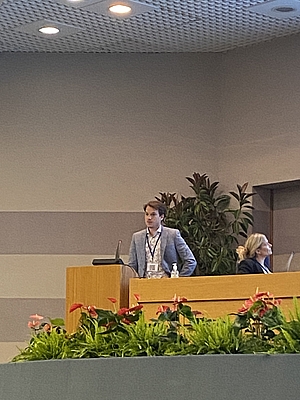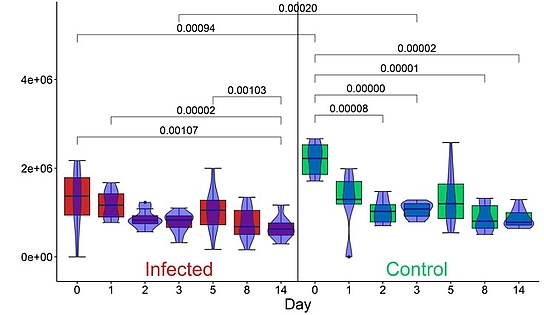IABR Summit Pisa I 12.06. - 15.06.2022
Programm und weitere Informationen
Plenary Session
|
Abstract Content
Starting in 1996 with first clinical studies in mechanically ventilated critically ill patients, our research was focused on exhaled VOC profiles in patients suffering from acute lung failure (ARDS /ALI). At the NATO meeting in Crete VOC analysis was still considered as a sideshow in relation to NO and breath condensate research, but we got into contact with important and inspiring researchers and ideas from the whole field. In the following years, we conceived many VOC related clinical studies in spontaneously breathing and mechanically ventilated patients. RoMBAT (Rostock Medical Breath Analysis and Technologies) improved sampling and analytical methods for breath profiling at the bedside and applied these techniques to different cohorts of patients (ARDS, SIRS, sepsis, cancer, heart surgery, brain injury…). In addition, breath analysis was extended to large animal models and volatiles emitted from (cell or bacterial) cultures to get better understanding of origins and exhalation kinetics of breath VOC biomarkers. This knowledge was used to identify and solve questions related to blood- breath correlations, confounding variables and data over fitting. The application of breath resolved real time monitoring further enhanced our knowledge on regular physiological effects on exhaled VOC concentrations and enabled monitoring of dynamic exhaled profiles in (ICU) patients during treatment/ therapy.
This lecture will give an overview on more than 20 years VOC research in a clinical context, research gaps identified, problems solved and lessons learned.

Oral Sessions
A
|
Abstract Content
Background: Due to their immediate exhalation after generation at the cellular level exhaled volatile organics (VOCs) may provide real-time information on pathophysiological mechanisms and host response to infections.
Methods: We conducted PoC real-time mass-spectrometry based consecutive breath profiling in 708 subjects under conditions of a realistic screening scenario in a COVID-19 test center. Recruited subjects were grouped for further comparisons, based on PCR confirmed infection status (infected by SARS-CoV-2 or other respiratory pathogens and healthy), RTqPCR cycle threshold (Ct) values and presence or absence of flu like symptoms.
Results: Exhaled VOC profiles of SARS-CoV-2 positive cases (n=36) differed from healthy (n=256) and other respiratory infections (n=416). VOC concentrations also differed between symptomatic and asymptomatic subjects. Unlike previous studies, we observed suppressions of most breath markers in COVID-19. Under-expressions of butyric acid was found as SARS-CoV-2 infection characteristic. Irrespective of tracible disease symptoms, dimethyl sulfide decreased with increasing viral loads. Other VOCs linked to immune host response were over-expressed in cases with respiratory pathogens other than SARS-CoV-2.
Conclusions: Alike recent metagenomic and bio-chemical reports, breath profiles of exhaled VOCs mirror interactions of virus with hosts’ cellular metabolism, immune homeostasis of the systemic microbiome. Decreased exhalations of specific volatiles can be attributed to suppressive effects of SARS-CoV-2 onto gut- or pulmonary microbial metabolism. Thus, breath analysis holds potential for monitoring SARS-CoV-2 infections rather than for primary diagnosis. Breath VOC profiling offers knowledge on host-virus crosstalk beyond conventional understanding of microbiology and non-invasive monitoring of pathobiological events linked to viral entry and disease manifestation.

Oral Sessions
|
Abstract Content
Background: Streptococcus suis is one of the five most important porcine pathogen worldwide, that causes a wide range of clinical diseases in swine with major economic losses. Due to its zoonotic pathogenicity S. suis can be transmitted to humans and has various clinical manifestations. Confirmation of infection is achieved by well established procedures but their technological limitations and complexities may lead to delays in diagnosis. Recent studies suggest that bacterial infections could be reflected through exhaled VOC profiles non-invasively.
Methods: In this in vivo study breath gas samples were taken from 11 spontaneously breathing pigs during a complete S. suis serotype 2 infection cycle at 11 time points. Breath sampling was carried out under high safety conditions with a sterile glass syringe in the alveolar phase of expiration after placing the pigs in a canvas sling. VOCs were preconcentrated onto triple bed needle trap devices (NTDs), thermally desorbed in the GC inlay and analyzed by GC-MS. In parallel, the headspace of feces samples was analyzed by SPME-GC-MS.
Results: The GC-MS assays provided reliable quantification of exhaled and headspace VOC profiles down to pptV level. During the monitoring process significant differences in 8 volatile organics (such as aldehydes, ketones, carboxylic acids and aromatic compounds) were detected between infected and non-infected animals. Exhaled VOCs showed significant changes linked to inflammation or bacterial metabolism. Changes in VOC concentrations over feces can be correlated to modifications in pigs gut microbiome.
Conclusions: Results underline the potential of VOC analysis for the monitoring of infectious diseases in vivo. As a quick and completely non-invasive method dynamic VOC profiling may add comprehensive information on infection processes.

Oral Sessions
Author Name: | Nele Kemnitz- Rostock University Medical Center |
Session Title: | Breath biomarkers of microbial infections |
Event Title: | Mass spectrometric breath screening of patients with pulmonary bacterial infections |
Co-Authors | Rasmus Remy, Phillip Trefz, Julia Bartels, Patricia Fuchs , Ann-Christin Klemenz, Leo Rührmund, Pritam Sukul, Wolfram Miekisch, Jochen K. Schubert |
Date: | Monday, June 13, 2022 |
Start Time: | 3:30 AM |
Location: | Pisa CNR |


Oral Sessions
Author Name: | Pritam Sukul - Rostock University Medical Centre |
Session Title: | Five shades of breath analysis |
Event Title: | Effects of COVID-19 protective face-masks and wearing durations onto respiratory-haemodynamic physiology and exhaled breath constituents |
Co-Authors | J. Bartels, P. Fuchs, P. Trefz, R. Remy, L. Rührmund, S. Kamysek, J. K. Schubert, W. Miekisch |
Date: | Tuesday, June 14, 2022 |
Start Time: | 2:50 PM |
Location: | Pisa, CNR |
Abstract Content
Background: While assumed to protect against coronavirus transmission, face-masks may have effects on respiratory-haemodynamic parameters. Here, we investigated immediate and progressive effects of FFP2 and surgical masks on exhaled breath constituents and physiological attributes in 30 adults at rest [1].
Methods: We continuously monitored exhaled breath profiles within mask space in older (age: 60–80 years) and young to mid-aged (age: 20–60 years) adults over the period of 15 and 30 min, respectively by high-resolution real-time mass-spectrometry (PTR-ToF-MS). Peripheral oxygen saturation, respiratory- and haemodynamic parameters were measured (noninvasively) simultaneously.
Results: Profound, consistent and significant (p-value≤0.001) changes in SpO2 (Adults>60_FFP2-15min: 5.8±1.3%¯, Adults>60_surgical-15min: 3.6±0.9%¯, Adults<60_FFP2-30min: 1.9±1.0%¯, Adults<60_surgical-30min: 0.9±0.6%¯) and pET-CO2 (Adults>60_FFP2-15min: 19.1±8.0%, Adults>60_surgical-15min: 11.6±7.6%, Adults<60_FFP2-30min: 12.1±4.5%, Adults<60_surgical-30min: 9.3±4.1%) indicate ascending deoxygenation and hypercarbia. Secondary changes (p-value≤0.005) to hemodynamic parameters (e.g. MAP: Adults>60_FFP2-15min: 9.8±10.4%) were found. Exhalation of blood-borne volatile metabolites e.g. aldehydes, hemiterpene, organosulfur, short-chain fatty acids, alcohols, ketone, aromatics, nitrile and monoterpene mirrored behaviour of cardiac output, MAP, SpO2, respiratory rate and pET-CO2. Exhaled humidity (e.g. Adults>60_FFP2-15min: 7.1±5.8%) and exhaled oxygen (e.g. Adults>60_FFP2-15min: 6.1±10.0%¯) changed significantly (p-value≤0.005) over time.
Conclusions: Breathomics allows unique physio-metabolic insights into immediate and transient effects of face-mask wearing. Physiological parameters and breath profiles of endogenous and/or exogenous volatile metabolites indicated putative cross-talk between transient hypoxemia, oxidative stress, hypercarbia, vasoconstriction, altered systemic microbial activity, energy homeostasis, compartmental storage and washout. FFP2 masks affected more pronouncedly than surgical masks. Older adults were more vulnerable to FFP2 mask induced hypercarbia, arterial oxygen decline, blood pressure fluctuations and concomitant physiological and metabolic effects.


Poster Sessions
Author Name: | Leo Rührmund - University Medicine of Rostock |
Session Title: | Poster session and industrial exhibition |
Event Type: | Poster Sessions |
Event Title: | Data visualization for real time mass spec-based breath analysis in clinical setups |
Co-Authors: | Phillip Trefz, Rasmus Remy, Julia Bartels, Ann-Christin Klemenz,, Patricia Fuchs , Nele Kemnitz , Pritam Sukul , Wolfram Miekisch , Jochen K. Schubert |
Affiliation: | Rostock University Medical Center |
Date: | Monday, June 13, 2022 |
Start Time: | 9:30 AM |
Location: | Pisa, CNR |
Abstract Content
Background: Mass spectrometry is an indispensable research tool for basic research and laboratory medicine. New instruments with better mass and time resolution produce more accurate data than ever before. The throughput is much higher and by new setups – often in real time – produced data sets are getting larger and larger. Quick and efficient interpretation of the data remains a great challenge since hundreds of compounds can be detected which makes it hard to identify the relevant substances. There is a need for improvement and standardization of data analysis, especially regarding first view and data evaluation.
Methods & Results: Therefore, we developed a tool with a graphical user interface, that performs automated statistical analysis and visualizes the data using box plots including labels of statistical significance on first sight. With this tool an easy comparison of sample types (e.g., two different patient groups) and/or changes of concentrations over a defined time period is possible. The boxplots can be enhanced by violin-plots and normalization of data on a chosen time point is possible. In contrast to other visualization techniques such as heatmaps, this tool includes fast and simple automated analysis for visualization of statistical significance. The tool is open source and based on the free coding language R. Therefore, adaptations to different research questions (e.g., statistical test or axis labeling) and implementation of additional statistical methods can easily be realized.
Conclusions: This new algorithm represents an innovative and effective tool for first data view in the field of bioanalytics. Perspectively, this kind of algorithm delivers visualization of data, making a quick preselection of potential biomarkers possible.

Verleihung des Anton Amann Award 2022
- The Anton Amann Award was established in 2015 by the International Association of Breath Research (IABR) to recognise outstanding achievements in breath-related research. The award is named in honour of IABR’s founder and inaugural chairman, Prof. Anton Amann (1956–2015†, Bregenz – Innsbruck, Austria). The benefactors of the award are the Polish Chemical Society, Marco Freek, Esq. (IABR Executive Director, Austria) and Prof. Boguslaw Buszewski (Poland).
- The Anton Amann Award is conferred to scientists, engineers or physicians who have made an outstanding contribution to the field of breath research. Achievements can be theoretical and/or practical, with emphasis on the development of methodologies for determining potential biomarkers of human disease states or the discovery and explanation of biochemical mechanisms thereof.
- The recipient will be selected by a specially-established Award Board comprising the benefactors Prof. Buszewski (Chairman) and Mr. Freek (Secretary), the IABR chairperson, chair-elect, and past-chair, the chair of the current IABR summit, and the editor-in-chief of Journal of Breath Research (IOP Publishing, UK). Voting is carried out anonymously via an electronic voting system. Legal recourse is excluded. Services and activities of the candidate relating to IABR are an integral aspect in evaluating the nominated candidates.
- The Anton Amann Award can be conferred to an individual only once.
- In exceptional and justified cases, the Award may be conferred to more than one nominee in a given year.
- The Medal Laureate will present a lecture during the upcoming conference/meeting organized under the auspices of the IABR (the IABR Breath Analysis Summits).
- The candidatures must be nominated by a registered member of IABR. The deadline for such a nomination is 3 months before the upcoming conference. Nominations should be sent to the secretary of the Award Board and the Chair of the IABR, stating the reasons for the nomination, including references to selected publications of the nominee. The nomination document must not exceed one page, including references.
- The award is presented by the IABR Chair or the Chairman and/or Secretary of the Anton Amann Award Board during the IABR conference of that year.





